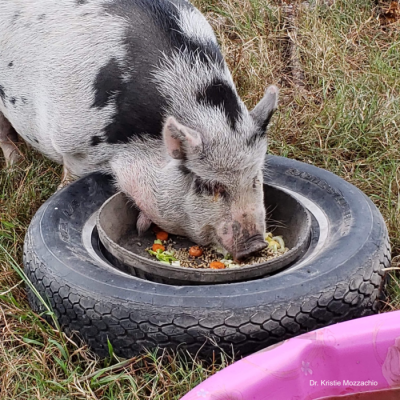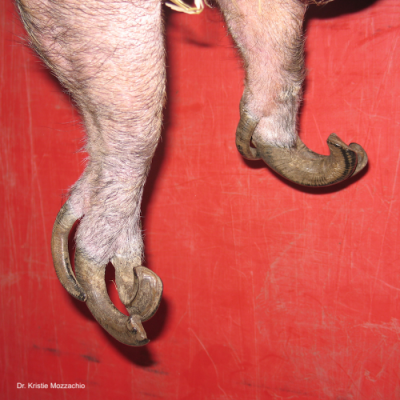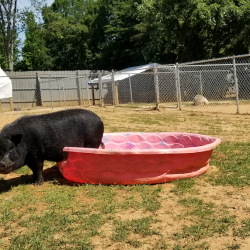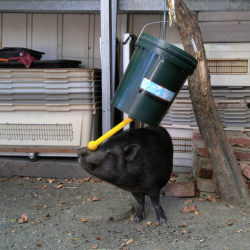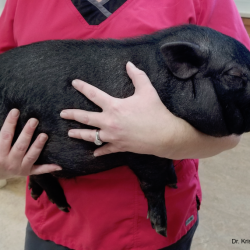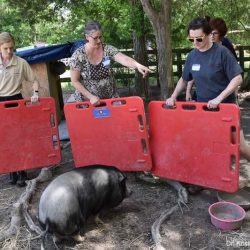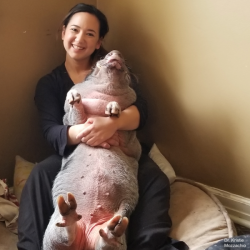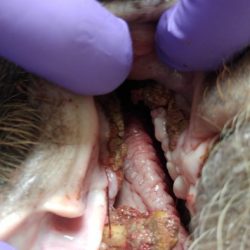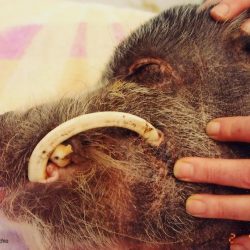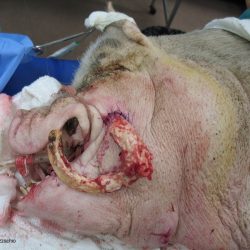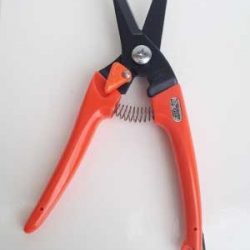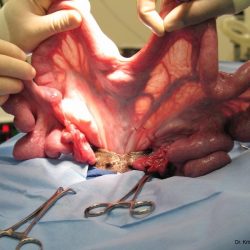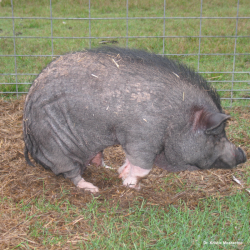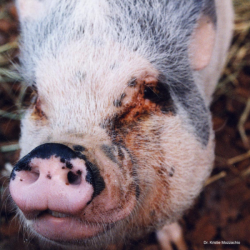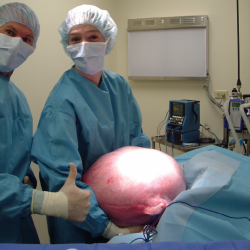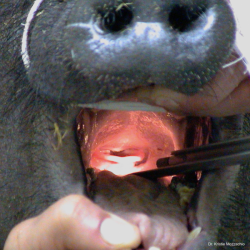Miniature Pig (Sus scrofa domesticus )
Natural history
Pigs were domesticated approximately 9,000 years ago from wild boars (Sus scrofa). In the 1960s, farmers developed a smaller dwarf pig from wild Vietnamese breeds that was more easily housed. Vietnamese potbellied pigs (also known as Asian or Chinese potbellied pigs or just potbellies) were first introduced to the United States in 1985. Since that time, the popularity of miniature pigs has waxed and waned.
The term “miniature” is used to describe a variety of smaller pig breeds as well as crossbreeds. There are at least 14 recognized breeds of miniature pigs, including the Vietnamese potbellied pig, the Juliana pig, the KuneKune, and others; many pets are mixed breed, of unknown origin. Terms such as “teacup”, “micro mini” and “nano pig” are marketing ploys rather than true breeds.
Taxonomy
Class: Mammalia
Order: Artiodactyla
Sub Order or clade: Suina
Family: Suidae
Physical description
Miniature pigs are stout, barrel-shaped animals with relatively large heads and short limbs.
Purebred Vietnamese potbellied pigs are usually all black with upright ears and a straight tail and grow to be 36-50 cm (14-20 in) tall at the shoulders. The adult size of other miniature pigs is much more variable.
Note: Adult size is not reached until 3-4 years of age
Sexual dimorphism
Both males and females have tusks (upper and lower canine teeth), however, the tusk root of the female closes at maturity and ceases to grow. In contrast, the male tusk retains an open root allowing continued growth, which is more rapid in intact boars than castrated males.
In addition, intact boars exhibit a few distinctly male characteristics, including: excessive facial hair, excessive hair on the distal limbs and tail, densely fibrous shoulder plates, a strong, offensive odor, and specific behavioral displays (see Behavior below) .
Diet
Wild pigs are opportunistic omnivores, eating roots, berries, and whatever else they can expose with their snout and hooves.
The pet pig diet should consist of a specially formulated miniature pig feed, such as Ralston Purina’s Mazuri®, Ross Mill Farm’s Champion™ Pig Food, Heartland, or Manna Pro. Mini pigs can also be offered an all-purpose livestock or equine feed. Commercial swine feed is not recommended for miniature pet pigs.
Feeds are often classified as a starter ration (for piglets in the process of being weaned), grower (fed until puberty), breeder, or maintenance. Maintenance rations are started at about 8 weeks of age.
Pigs are extremely food motivated and always appear hungry. Never feed a pig ad libitum; rather, carefully ration food, dividing the daily volume into at least two small meals.
| Young piglet | ½ cup per 15-20 lb/day | ½ cup per 7-9 kg/day |
| Adult | 1 cup per 50-80 lb/day | 1 cup per 23-36 kg/day |
Also offer fiber, in the form of grass hay or allow the pig to graze, to help control hunger.
Treats are unnecessary but, if offered, vegetables are the best option. The pig should be asked to perform a task (even as simple as coming when called) before feeding a treat. Pigs notice WHEN they receive treats, not HOW MUCH they receive – an important tip for owners dieting their overfed pets.
Secure food and water bowls to the ground so the pig cannot climb in the dishes or tip them over. Provide a bowl with a weighted bottom and/or wide base; alternatively, secure the bowl within the center of a tire (select image below to enlarge). Be sure bowls are low enough for the pig to easily access. Place bowls on an easily cleaned surface, like a shower stall or a large, shallow tray. Fresh water should be available at all times (see below).
Husbandry
| Indoor | Strict indoor life (e.g. apartment dwelling) is never a good option for pet pigs. Pigs restricted to the indoors will root on objects like carpet and walls. In addition, hoof overgrowth tends to be more extreme in indoor-only pigs (select image left to enlarge) and boredom is an issue as well. Confine unsupervised, indoor pigs to a “pig-safe room” and provide a designated rooting area and/or rooting box (see enrichment below) to minimize destruction. |
| Outdoor pen | All pet pigs should spend several hours each day outdoors exploring and rooting the ground. The pen should be at least 2.5 x 4.5 m (8 x 15 feet) per pig, although more space promotes more exploration and exercise. Shade should be provided to prevent sunburn.
Fencing must be strong and secure. Suggested materials include wood, chain link, hog panels, and T posts. At least 30 cm (1 foot) of mesh fence should extend beneath the ground to prevent digging beneath the fence. Note: Fencing must not only keep pigs in but keep predators such as dogs out. Rough surfaces, like a concrete patio or pavers in the feeding area or at the entrance to a shelter, will help to keep the hooves worn (see hoof care below). |
| Pig house | The pen should include a clean, dry, draft-free, insulated “pig house” for sleeping and nesting, measuring approximately 2 square meters (6 sq ft). Flooring should provide good traction (e.g. rubber stall mat or outdoor carpet). During cold weather, a commercial pig heating blanket or a heat lamp safely placed out of reach may be used with caution.
Provide proper nesting material such as straw/hay, blankets (fleece recommended as these are more resistant to ripping), sleeping bags, and/or aspen shavings (avoid cedar). Bedding must be deep enough to allow rooting or for the animal to completely cover itself. Replace wet or dirty bedding daily. Replace ripped blankets to prevent accidental foreign body ingestion. |
| Environmental temperature | Adult potbellied pigs are most comfortable at environmental temperatures between 15–24°C (60–75°F).
Pigs are incapable of sweating (see Integument below) and are susceptible to overheating at temperatures exceeding 30°C (85°F). Pigs will begin to pant as they get warm, but this is often insufficient for cooling. Pigs require fans and water for soaking when it is hot; mud puddles are a great option as these allow for both cooling and sun protection via a coating of mud. Shade is also important because pigs have sensitive skin that can sunburn. |
| Relative humidity | 50% |
| Drinking water | Many pigs prefer to move back and forth between their water and food bowls at feeding time. Some pigs have difficulty swallowing dry pellets and may require water added directly to feed to prevent choking.
Water intake sometimes decreases during the winter or in overweight pigs. Restricted access to water can lead to health problems such as cystitis and urolithiasis. Offering warm or room temperature water may encourage drinking, especially during colder weather. Adding a few tablespoons of juice (cranberry, orange) may also encourage drinking. |
| Water for soaking | Water for soaking should be provided in a separate container from drinking water. A child’s wading pool is suitable for this purpose, but the sides may need to be cut down to accommodate the pig’s short legs (select images left to enlarge). It may also be helpful to provide flooring with traction in the pool (e.g. outdoor carpet, rubber mat, bathtub appliqués). There are also heavy duty, rectangular, non-slip, vinyl pools with low, soft, padded sides made specifically for miniature pigs. |
Activity |
Rooting is common and is normal pig behavior (select image left to enlarge). Pigs are also good runners and jumpers and skilled swimmers, although they generally prefer less-athletic activities once adulthood is reached.
Pigs are also normally quite vocal, with a large vocabulary of sounds. |
| Social | Pigs are highly social and intelligent animals that do best in a herd of conspecifics (at least 2 pigs). Aggression can stem from territorial disputes over sleeping quarters or food or may simply be an effort to gain status in the herd. In single-pig households, the human family is the pig’s “herd” and aggressive behaviors are common if not recognized early and appropriately modified. These behaviors tend to emerge around 2 years of age when a pig develops its social standing within the herd. |
| Enrichment | Free-ranging pigs forage for food by grazing and rooting for approximately 7 hours each day (V. Tynes, email message to author, June 12, 2019). Offer pet pigs the opportunity to graze on grass or grass hay, which provides an excellent way to hide food, slow feeding, and promote foraging. For pigs that spend some time indoors, a rooting box is also recommended. Feeder puzzles can also provide a challenge to pet pigs (select image left to enlarge). Pigs don’t “play” with toys the way a dog or cat might; enrichment revolves around exploration of new and interesting items or environments and, of course, food. |
| Reproductive | Sexual behavior begins very early in pigs—before weaning—and can include: unpredictable behavior, aggression, rooting, as well as mounting and destructive behaviors. Intact pigs can be difficult to house train.
Females can display cyclic moodiness, mounting, and urinary marking every 21 days or so. Intact males display behaviors, such as kneading the ground (similar to a cat), mounting, and intense foaming at the mouth (unrelated to anticipation of food), as well as frequent vocalizations or “huffing” noises. |
Normal physiologic data
| Life expectancy | 14-21 years (average 15-18) |
| Body weight | Miniature pigs typically weigh between 32-68 kg (70-150 lb). Mini pigs reach half their adult weight by about 1 year of age and will continue to grow until 3-4 years of age when growth plates completely fuse. |
| Body temperature | 37.6-39°C (99.7-102.2°F) |
| Heart rate | 70-80 bpm, often higher during restraint Up to 200 bpm in piglets |
| Respiratory rate | 12-18/minute Up to 40/minute in piglets |
| Reproductive data | See Anatomy/physiology below |
| Weaning age | 6 weeks or more |
Anatomy/ physiology
| Dentition | I3/3 C1/1 PM 4/4 M 3/3 = 44
Piglets are born with eight teeth called “needle teeth”. In commercial pigs, these teeth are sometimes clipped to prevent damage to littermates or to the sow’s teats. This practice is not typically necessary in miniature pigs. Deciduous teeth erupt until about 3 months of age; permanent teeth are present by about 20 months. Tooth loss of premolars and molars is common in older pigs. |
| Gastrointestinal |
|
Integument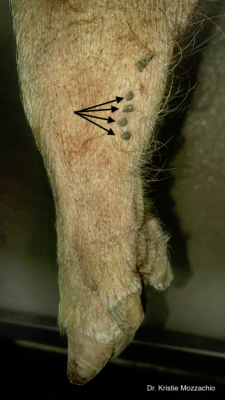 |
Although pigs possess some sweat glands, they are not functional and do not respond to thermoregulatory cues. Therefore, pigs are susceptible to overheating at temperatures exceeding 30°C (85°F). Overheated pigs begin to pant as they warm, but this is often insufficient for cooling, and this is one reason pigs wallow in mud.
Carpal glands are scent marking glands found on the medial aspect of the forelegs (select image left to enlarge). White to brown, pasty debris can sometimes be expressed from the glands and inspissation of secretion is common. |
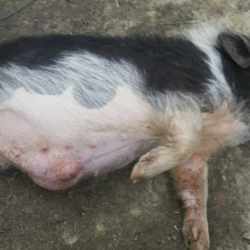 |
The preputial diverticulum fills with foul-smelling smegma in intact males. This sac can become quite large and prominent and should not be confused with an umbilical hernia (select image left to enlarge). |
 |
The mental gland found on the ventral aspect of the chin has both scent-marking and tactile functions (select image left to enlarge). |
| Musculoskeletal | Adaptations of the skull for rooting behavior include:
Pigs have one pair of principle digits (the two main toes that they walk on) and one pair of accessory digits (declaws) per leg. |
Reproduction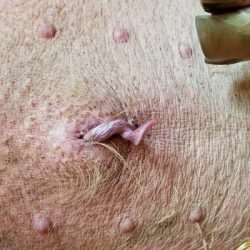 |
Penis: Curved with a sigmoid shape and a corkscrew tip (select image left to enlarge), which correlates with the interdigitating structure of the long cervix.
Puberty: As early as 2-4 months of age. Pigs exhibit sexual behavior before they are weaned and are fertile by 3 months of age. Estrous cycle: 17-25 day intervals (average 21) Estrus: 1-3 days
Gestation: 112-116 days
Litter size: average 6-8, range 2-15
Birthweight: 340-794 g (0.75-1.75 lb)
|
| Respiratory | See Therapeutics below for a description of laryngeal anatomy. |
| Special Senses
|
Pigs possess a good sense of hearing. The ear canal is extremely narrow, filled with debris, and otoscopic examination is generally not feasible. Miniature pigs often produce large amounts of dark brown, flaky to waxy, aural secretions (see eyes-ears-nose below). Although this resembles the secretions produced in dogs or cats with ear mite infestation, this secretion is normal for a miniature pig.
Pigs have generally poor vision. Pigs possess a keen sense of smell. The nostrils are located at the end of the snout and are capable of closing when the pig is rooting. |
Restraint
| Manual
|
Restraint is likely the most difficult aspect of dealing with miniature pig patients. Pigs are a prey species: sows do not pick up or restrain their babies, but predators do…
Pigs are susceptible to exertional myopathy, and although uncommon in pet pigs, this condition is extremely painful and difficult to treat. Minimize restraint whenever possible, so there is less squealing and less stress for owners and veterinary health staff. Oral trazodone (10 mg/kg PO) and gabapentin (20 mg/kg PO) may be helpful when administered together the night before and again 2 hours prior to the veterinary visit. It also helps if the pig is harness trained (pig-specific harnesses are commercially available, e.g. Comfort Fit Safety Harness) and/or crate-trained. Crates can be partially dismantled, so the pig can be examined (or sedated) while confined in the bottom half of the pet carrier. Always expect squealing when restraining a pig. Hearing protection is recommended. It is helpful to learn to differentiate between different pig vocalizations (anger/annoyance versus fear versus pain). It is much safer to perform exams on the floor instead of a table as many pigs will try to leap off. Solid, non-slip flooring is also a must when working with pigs, as slippery surfaces guarantee a panicked patient even before the procedure begins. Rubber-backed bath mats work well for this purpose. DO NOT use a hog snare OR pick up mini pigs by the legs as shoulder, lower back, or leg injuries can occur. Also, subclinical degenerative joint disease may be present and can become clinical after inappropriate restraint. Restrain a small to medium-sized pig by placing one hand beneath the rump and the other hand in front of the forelimbs and under the neck (rather than under the chest) (select top image left to enlarge). Larger pigs can be handled in narrow chutes or cornered using crowd boards or sorting panels (select middle image left to enlarge), which are commercially available through various suppliers, including Ross Mill Farm. |
| Chemical | Deep sedation or light general anesthesia is often required for most diagnostic or therapeutic procedures.
See Therapeutics below. |
Preventive medicine
| Physical examination: | Recommend 6-12 hours of fasting prior to physical exam in case sedation is necessary. Also instruct owners to bring their pig’s daily food ration or favorite treats.
Visual examination should include observation of gait, conformation, body condition score, skin health, hoof condition, respiratory rate and character. |
| Vaccination | Vaccination protocols vary, and there is no widely accepted standard for miniature pigs. Recommendations are based on diseases common in the area, potential exposure, age, breeding status, zoonotic potential. Minimum recommendations for miniature pigs may include:
Begin vaccinations at 8-12 weeks of age; administer two doses 14 days apart, then annually. |
| Fecal parasite testing | Fecal flotation should be performed during yearly routine physical exam to monitor for gastrointestinal parasites. In larger “open” herds such as a pig sanctuary, fecal monitoring should be performed more frequently, a minimum of twice yearly. |
| Dental
(tusk trim)
|
Routine dental care should be part of suid preventive health care, and routine cleaning should ideally be performed as in a dog or cat (select top image left to enlarge).
Tusks can become long and extremely sharp, and tusk trims may be necessary to prevent injury to humans and other animals or damage to household furniture or flooring. Tusks can also become caught on caging or they may even grow long enough to penetrate the flesh of the face (select middle image left to enlarge). Tusks should be trimmed well above the gum line using obstetric saw (Gigli) wire and edges can be smoothed with a file or Dremel tool. Intact males may require a tusk trim every 6-12 months and neutered males every 1-5 years. Females typically do not require tusk trims. Dental abscesses are a potential complication (select bottom image left to enlarge), therefore tusk trims should be kept to a minimum and performed only when needed. |
| Hoof care
|
A normal healthy pig will require a hoof trim about once a year, typically beginning at 1-2 years of age. The frequency of trimmings may increase with indoor-only environment, hoof deformities, cracks, or the development of arthritis.
The frequency of hoof trims depends on genetics, age, diet, activity level, and the environmental substrate provided. Rough surfaces, like concrete or patio pavers in the feeding area or at the entrance to a shelter, will help to wear the hooves. Some owners are able to train their pigs to allow hoof trim, and this is strongly encouraged. Small nippers are recommended for owners and are available from online suppliers such as RossMillFarm.com |
| Surgical sterilization
|
Spaying and neutering is recommended to improve pet quality, reduce odor in males, and lessen some destructive or undesirable behaviors. Surgical sterilization also prevents uterine infections and tumors in female pigs as well as testicular tumors in male pigs.
Castration
Ovariohysterectomy
|
Important medical conditions
| Obesity | Pigs easily gain weight, and obesity is a common problem in pet pigs. The condition is often associated with free choice feeding (or overfeeding of inappropriate items such as dog food or table scraps) and lack of exercise.
Entropion and arthritis are common problems in obese pigs, and obesity contributes to cardiopulmonary disease as well. Vision and hearing are often impaired due to physical interference of fat deposits over the eyes and around the ears. Obesity can also be correlated with very low water consumption, which can lead to cystitis and urolithiasis. The risk of obesity in pet pigs can be minimized with:
|
| Musculoskeletal | Erysipelas can cause lameness due to polyarthritis.
Osteoarthritis is extremely common in elbow joints, carpus, tarsus, phalanges, and spine, particularly in obese pigs. Clinical signs can include difficulty rising, reduced activity, and lameness. Some animals walk on their “knees” (carpus), while others sink onto their haunches, displaying a hunched posture that can resemble constipation (select image left to enlarge). Management relies upon regular hoof trims, non-slip surfaces, bedding to minimize exposure to cold or slippery surfaces, glucosamine supplements, anti-inflammatories, and pain medications. Alternative therapies such as acupuncture or laser may be beneficial. Degenerative joint disease is an important reason for euthanasia in older, otherwise healthy pigs. |
| Eyes-Ears-Nose
|
Miniature pigs normally produce large amounts of dark brown, flaky to waxy, ear secretions (select image left to enlarge) that can be removed with a gauze square or cotton ball, if desired, but ear cleaning is not necessary unless there is a problem like otitis.
Otitis media/interna is secondary to ascending infection (caused by Streptococcus sp., Pasteurella multocida, rarely Mycoplasma) along the Eustachian tubes. DO NOT place fluids of any kind into a pig’s ear. Some pigs develop a head tilt (temporary or permanent) after ear cleaning solutions are used. Entropion can be genetic and involve either upper or lower lids; surgical correction may be necessary. It is also a common problem in obese pigs; primary treatment in these cases involves weight loss first and foremost. Atrophic rhinitis is a condition in young, growing pigs caused by Pasteurella multocida and Bordetella bronchiseptica. Clinical signs initially include epistaxis, sneezing, nasal discharge; affected pigs may later develop snout deviation as a result of nasal turbinate destruction. Many pigs develop a red-brown ocular discharge (select image left to enlarge). Although this is frequently a normal finding, rule out mechanical irritation caused by entropion or foreign material. Allergies may also play a role. Gently remove discharge with a warm, wet cloth or baby wipe as this secretion can build up to a thick crust and cause irritation to the underlying skin. |
| Integumentary
|
Diamond skin disease (see Erysipelas below)
“Dippity pig” or erythema multiforme: The cause of this condition is unknown, but the disorder may run in families. It tends to affect animals <2 years of age, and is precipitated by a stressful event (e.g. transport, new human or animal addition to household, fight with another pig, thunderstorm). Disease presents as acute onset of severe lumbar pain–causing the pig to repeatedly “dip” into a sitting position while making distress vocalizations–and extremely painful, serosanguineous, burn-like lesions that may develop along the spine over the course of several hours (akin to shingles in people). Although this illness has been described as erythema multiforme, it is not entirely consistent with the disease seen in other species. Various medications have been tried in the treatment of “dippity pig”, including antibiotics, steroids, and pain relievers, but the stress of veterinary exam and medicating may not be worthwhile. “Dippity pig” usually resolves on its own within 24-48 hours, and the pig returns to normal. This condition is best managed by a low-stress environment (i.e. alone in a warm, quiet, dim room with a pile of blankets or isolated in a stall with a pile of hay). This condition can recur. Pig louse (Hematopinus suis) |
| Gastrointestinal |
Constipation Endoparasites Gastrointestinal foreign body Gastric ulceration Tusk abscess |
| Urogenital
|
Urolithiasis
Struvite, calcium carbonate, and calcium apatite uroliths can develop in males. Surgical treatment consists of bladder decompression via cystotomy and clearance of the urethra by retro- and normograde flushing or by tube cystostomy (16-20 Fr Foley catheter placed into the bladder apex). Uterine tumor Older intact females often develop cystic endometrial hyperplasia and uterine tumors (select image left to enlarge). Approximately 75% of intact females >10 years of age develop uterine tumors, most commonly leiomyomas. These tumors may grow large enough to cause illness and death and surgical removal of these masses is technically difficult, expensive, and stressful for the patient. Therefore early spay is highly recommended for non-breeding females. |
| Toxic exposure | Pigs can frequently get into protected areas (like the area behind the refrigerator) due to their voracious appetite and their predilection for rooting paired with their strength.
Gastric lavage is the safest management technique if ingestion of a toxin is recent (<4-6 hours) and lavage is not contraindicated (e.g. caustic substance). Activated charcoal can also be hidden in baby food. DO NOT administer hydrogen peroxide or mineral oil via syringe or drench due to the danger of aspiration. |
| Erysipelas | This systemic disease, caused by the soil bacteria Erysipelothrix rhusiopathae, is associated with anorexia, lethargy, high fever (>40°C or 104°F), malaise, lameness due to polyarthritis, discolored skin (diamond skin disease), and potentially death. Slightly raised, diamond-shaped skin lesions do not occur commonly but are pathognomonic for this disease. Acute, subacute, and chronic forms of disease are described. This disease also has zoonotic potential.
Immediate treatment is very effective. Historically, penicillin is the drug of choice although a long-acting beta-lactam antibiotic such as Excede® (ceftiofur sodium) reduces the need for frequent injections. A non-steroidal anti-inflammatory agent, such as flunixin or meloxicam, is also indicated to reduce fever. Tetracycline, chlortetracycline, lincomycin, and tylosin are also effective. |
Zoonotic potential
Erysipelas
Sarcoptic mange
Swine influenza virus infections have been documented in people. Human influenza viruses have also been occasionally isolated from pigs.
Diagnostics
| Venipuncture | An ideal location for blood collection in miniature pigs is the radial vein located on the medial aspect of the forelimb.
Jugular venipuncture is performed by placing the pig on its back (see pig flip). Pull the forelimbs caudally and collect blood from the right jugular furrow, a “trough” to the right of the manubrium of the sternum, with the needle angled toward the opposite (left) shoulder. Small blood volumes can be collected from the tail vein in larger pigs (ventral midline of tail base, similar to collection in the bovine). Other venipuncture sites include saphenous, femoral, cephalic veins as well as the cranial vena cava. Auricular veins are difficult to access in a conscious animal and allow for only limited volume collection due to the small, collapsible vessels. Auricular veins are also one of the only readily accessible sites for intravenous catheterization so should be conserved, especially in sick animals. |
References and further reading
References
Chum H, Pacharinsak C. Endotracheal intubation in swine. Lab Anim 41(11):309-3011, 2012.
Mini Pig Info website. Available at https://www.minipiginfo.com/. Accessed on June 9, 2019.
Mozzachio K. Basic potbellied pig care. Dec 2017.
Mozzachio K, Tynes VV. Recognition and treatment of pain in pet pigs. In: Egger CM, Love L, Doherty T (eds). Pain Management in Veterinary Practice . Ames, Iowa: John Wiley & Sons, Inc.; 2014.
Seibert LM, Powers LV. Miniature pigs: Managing common medical and behavior issues. Proc ExoticsCon 2018:597-636.
Sutherland-Smith M. Suidae and Tayassuidae (wild pigs, peccaries). In: Miller RE (ed). Fowler’s Zoo and Wild Animal Medicine, Volume 8. St. Louis: Elsevier; 2014:568-584.
Tynes VV, Mozzachio K. Miniature pigs. In: Carpenter JW, ed. Exotic Animal Formulary. 5th ed. St. Louis, MO: Elsevier Saunders;2018:558-574.
Zimmerman JJ, Karriker LA, Ramirez A, et al (eds). Diseases of Swine, 11th ed. Hoboken: John Wiley & Sons; 2019.
Mozzachio K, Pollock C. Basic information sheet: miniature pig. LafeberVet Web site. July 9, 2019. Available at https://lafeber.com/vet/basic-information-sheet-miniature-pig/

